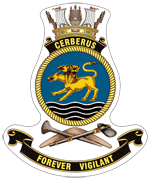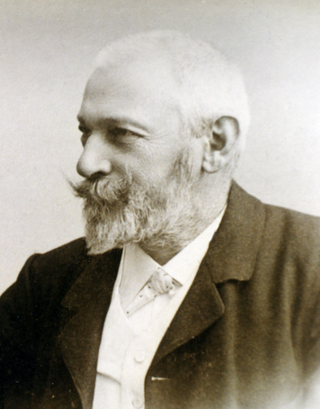
In Greek mythology, Cerberus, often referred to as the hound of Hades, is a multi-headed dog that guards the gates of the Underworld to prevent the dead from leaving. He was the offspring of the monsters Echidna and Typhon, and was usually described as having three heads, a serpent for a tail, and snakes protruding from multiple parts of his body. Cerberus is primarily known for his capture by Heracles, the last of Heracles' twelve labours.

HMAS Cerberus is a Royal Australian Navy (RAN) base that serves as the primary training establishment for RAN personnel. The base is located adjacent to Crib Point on the Mornington Peninsula, south of the Melbourne City Centre, Victoria, Australia. The base is also an official bounded locality of the Shire of Mornington Peninsula and is the only naval base to have a specific listing in the Australian census. HMAS Cerberus recorded a population of 1,124 at the 2021 census. A section of the base centred around the Parade Ground was added to the Australian Commonwealth Heritage List on 22 June 2004, known as the HMAS Cerberus Central Area Group.

Dr. María de Lourdes Dieck-Assad is a Mexican economist who has held positions in academia, an international organization, government and business, including professorships in the United States and Mexico as well as serving as Mexico's ambassador to Belgium, Luxembourg and the institutions of the European Union from 2004 to 2007. For her service in this capacity, she was awarded the Grand Cross of the Order of the Crown of Belgium. She attended the Monterrey Institute of Technology and Higher Education from 1971 to 1975, graduating with a bachelor's in economics. She received her master's in 1976 from Vanderbilt University and her doctorate in the same field from the University of Texas in Austin in 1983 with a dissertation entitled “The effect of economic shocks under different monetary procedures and different economic structures,” which she wrote as an intern at the Brookings Institution. She has said that she wanted to work to make an impact on Mexico since she was studying as an undergraduate, mostly in economic and social issues. Her husband is economist Pedro Quintanilla Gómez-Noriega. They lived in Austin, Texas for five years, where they both pursued doctoral studies in Economics. Then they went to live in Washington, DC where both worked. They returned to Mexico in 1992. When an opportunity came for Dieck-Assad to represent Mexico in Europe, she received the full support of her husband and her three children, who were already in high school and college.

Cerberus is a large "dark spot" located on Mars and named after the mythical dog Cerberus. The arcuate (curved) markings in the upper right are in the Amazonis plains and may be sand drifts. The volcano Elysium Mons, a yellow area north of Cerberus, has several channels radiating from its flanks. The three bright spots, upper left, are volcanoes partially veiled by thin clouds.

Cerberus Capital Management, L.P. is a global alternative investment firm with assets across credit, private equity, and real estate strategies. The firm is based in New York City, and run by Steve Feinberg, who co-founded Cerberus in 1992, with William L. Richter, who serves as a senior managing director. The firm has affiliate and advisory offices in the United States, Europe and Asia.
The American Elm cultivar Ulmus americana 'Nigricans'Dieck was cloned from a selection made from seedlings raised by the Zöschener Baumschule, Zöschen, Germany, and listed by Georg Dieck with a brief description in Haupt-catalog der Obst- und gehölzbaumschulen des ritterguts Zöschen bei Merseburg, 1885.
The putative Wych Elm cultivar Ulmus glabra 'Fastigiata Macrophylla' was first mentioned by Dieck in the Zöschen catalogue in 1885 as Ulmus montana forma fastigiata macrophylla, without description. Hartwig added a description in 1892. Berndt received "from a renowned nursery in Holstein" an Ulmus montana fastigiata macrophylla, possibly the same clone, in 1903, which he listed and described as Ulmus glabra fastigiata in Graf von Schwerin's Mitteilungen der Deutschen Dendrologischen Gesellschaft (1915).
The elm cultivar Ulmus 'Rufa' [:rufous-coloured] was listed as U. campestris f. rufa by Georg Dieck, of Zöschen, Germany, without description in Haupt-catalog der Obst- und gehölzbaumschulen des ritterguts Zöschen bei Merseburg, Nachtrag I (1887), though it had been in cultivation for some decades before this date. It was considered "possibly Ulmus carpinifolia" by Green.

The Cerberus Fossae are a series of semi-parallel fissures on Mars formed by faults which pulled the crust apart in the Cerberus region. They are 1235 km across and centered at 11.28 °N and 166.37 °E. Their northernmost latitude is 16.16 °N and their southernmost latitude 6.23 °N. Their easternmost and westernmost longitudes are 174.72 °E and 154.43 °E, respectively. They can be seen in the Elysium quadrangle.

Pim Island is located off the eastern coast of Ellesmere Island, part of the Qikiqtaaluk Region of the Canadian territory of Nunavut. Located within the Arctic Archipelago, it is a part of the Queen Elizabeth Islands.

Georg Dieck was a German entomologist and botanist.
Anillus is a genus of ground beetles in the family Carabidae. There are about 19 described species in Anillus.
Geocharis is a genus of ground beetles in the family Carabidae. There are more than 40 described species in Geocharis.
Aphaenops is a genus of beetles in the family Carabidae, containing the following species: All species in the genus are obligate troglobites, and each species is usually endemic to a single cave system; they are unpigmented, and have no functional eyes.
Aphaenops bucephalus is a species of beetle in the subfamily Trechinae. It was described by Dieck in 1869.

The Ulmus pumila cultivar 'Aurescens' was introduced by Georg Dieck at the National Arboretum, Zöschen, Germany, circa 1885. Dieck grew the tree from seed collected in the Ili valley, Turkestan by the lawyer and amateur naturalist Vladislav E. Niedzwiecki while in exile there. Dieck originally named the tree U. pinnato-ramosaf.aurescens.

Katharina Müller is a German competitive ice dancer. With her skating partner Tim Dieck, she is a two-time German national champion and has won many senior international medals, including two silver medals on the ISU Challenger Series and three gold medals at the German NRW Trophy. They have represented Germany at the European and World championships.

Tim Dieck is a German competitive ice dancer. With his former skating partner Katharina Müller, he is a two-time German national champion and has won many senior international medals, including two silver medals on the ISU Challenger Series and three gold medals at the German NRW Trophy. They have represented Germany at the European and World championships. In December 2022, it was announced that Dieck had teamed up with British-Spanish ice dancer Olivia Smart.
The Field Elm cultivar Ulmus minor 'Viminalis Gracilis' [:'slender'] is a form of U. minor 'Viminalis'. Cultivars listed as Ulmus gracilisHort. by Kirchner (1864), and as U. scabra viminalis gracilisHort. by Dieck (1885), were considered by Green to be forms of Melville's U. × viminalis. A 1929 herbarium specimen held at the Hortus Botanicus Leiden is labelled U. campestris var. viminalis f. gracilis, implying a cultivar that differed from the 'type' tree.

Tammo tom Dieck is a German mathematician, specializing in algebraic topology.











